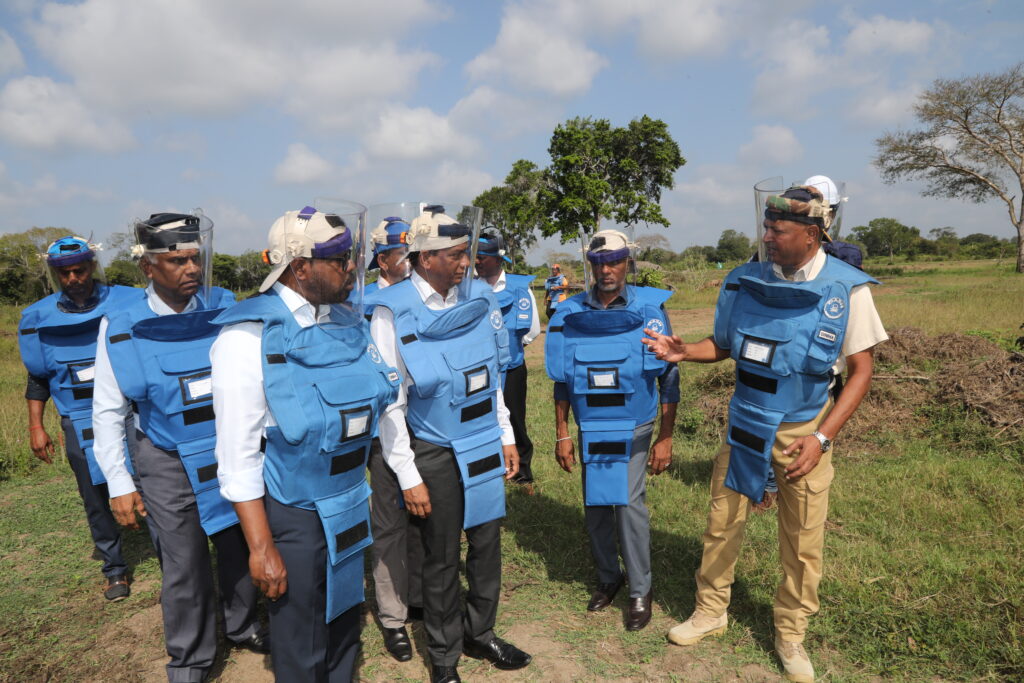Field Visit by the Hon. Minister of Urban Development, Construction and Housing to Mine Action Sites in Mullaitivu – 24 April 2025

Field Visit by the Hon. Minister of Urban Development, Construction and Housing to Mine Action Sites in Mullaitivu The Hon. Mr. Anura Karunathilaka, Minister of Urban Development, Construction and Housing, conducted an official field visit to Mankulam in the Mullaitivu District on 24th April 2025 to observe ongoing humanitarian demining activities in the region.The Hon. Minister was accompanied by the Hon. Mr. T.B. Sarath, Deputy Minister; Mr. Ranjith Ariyaratne, Secretary to the Ministry; and Mr. M.M. Nayeemudeen, Additional Secretary and National Director. The demining site visited — Mullai Veedhi in Mankulam — is operated by Delvon Assistance for Social Harmony Sri Lanka (DASH), a long-standing partner in Sri Lanka’s mine action programme. During the visit, the DASH Programme Manager and Operations Manager provided a detailed briefing on operational progress, technical procedures, and safety protocols being followed in accordance with national Standard Operating Procedures (SOPs). In fact, the HALO Trust Programme Manager, Operations Manager, MAG Operations Manager, and SHARP Operations Manager also participated in the visit and expressed their contributions and suggestions for the way forward in the mine action programme. Also present during the visit were valuable deminers and other dedicated staff from DASH, who continue to work tirelessly in challenging conditions to clear landmines and explosive remnants of war (ERW). In addition, officers from the Regional Mine Action Office (RMAO) in Kilinochchi participated and contributed to the discussions on regional coordination and progress. Even 15 years after the end of Sri Lanka’s internal conflict, communities in the Northern and Eastern Provinces still face risks from landmines and ERWs. The Hon. Minister expressed deep appreciation for the courage and dedication of all personnel involved in mine action. “Although my visit lasted only a few hours, it left a lasting impression on me — of the magnitude of the challenge, the courage of the operators, and the resilience of the communities. I was deeply moved by the stories of individuals and families who live amidst the risk of hidden explosives. As a fellow Sri Lankan and as a responsible Minister, I am committed to doing everything within my capacity to ensure that they can live safely, with dignity and peace of mind.” The Hon. Minister also acknowledged the critical role of mine action partners in restoring land to safe and productive use and reaffirmed the full support of the Ministry of Urban Development, Construction and Housing in achieving a mine-free Sri Lanka by 2028. View Images – Field Visit by the Hon. Minister of Urban Development, Construction and Housing to Mine Action Sites in Mullaitivu – 24 April 2025
Sri Lanka Participates in the 28th International Meeting of Mine Action National Directors and United Nations Advisers in Geneva

Mr. M.M. Nayeemudeen, the National Director for Mine Action, represented the Government of Sri Lanka at the National Directors Meeting held in Geneva from 8 to 11 April 2025. He was accompanied by officials from the Sri Lankan Embassy in Switzerland. During his visit, Mr. Nayeemudeen held discussions with donor representatives from German Federal Foreign Office (GFFO) to explore potential areas of support for Sri Lanka’s Mine Action Programme under the German Humanitarian Assistance. He also met with UN agencies, including UNICEF, to seek their continued assistance and engagement in mine action efforts across the country. A key highlight of his participation was the sharing of Sri Lanka’s success story in mine action, with a particular focus on the country’s Completion Strategy and Completion Survey process. These initiatives are central to achieving the country’s Article 5 obligations under the Anti-Personnel Mine Ban Convention by the target date of 1 June 2028. In addition, Mr. Nayeemudeen engaged with GICHD and various international mine action partners to share Sri Lanka’s experiences and discuss collaborative approaches to overcoming remaining challenges in the path toward completion. Discussions emphasized the importance of sustained support from donors and partners to address critical needs and ensure long-term success. During his visit, the following areas were highlighted through the media under the arrangements made by GICHD: How IMAS and NMAS have helped improve mine action in Sri Lanka; challenges and opportunities with standards In 2010, Sri Lanka developed its National Mine Action Standards (NMAS), aligned with the International Mine Action Standards (IMAS), through extensive consultations and collaboration with all mine action operators and relevant stakeholders. These standards cover all the areas such as land release processes, clearance methodologies (manual demining, mechanical clearance, battle area clearance), non-technical surveys, Explosive Ordnance Risk Education (EORE), Explosive Ordnance Disposal (EOD), Quality Management, and Marking of hazardous areas etc… These standards have significantly contributed to the effectiveness and consistency of mine action activities in Sri Lanka. They have enabled the programme to make informed and timely decisions on the ground and fostered a common understanding among government authorities, local and international stakeholders, and the donor community. Furthermore, the adherence to NMAS and was instrumental in Sri Lanka’s accession to the APMBC, which came into effect on 1 June 2018. The recently adopted Mine Action Completion Strategy 2023–2027 reflects a comprehensive approach to achieving Sri Lanka’s Article 5 commitments. One of the key achievements under this strategy has been the development of national standards for Completion Survey, enhancing the transparency and credibility of the land release process. As of now, out of approximately 1,400 GN divisions in suspected hazardous areas, 966 have been recommended for official declaration as cleared of mine and explosive ordnance (EO) threats. In order to achieve the obligations, The Completion Survey supports this goal by enabling consistent and transparent documentation of cleared administrative units. This demonstrates the Government’s commitment to applying All Reasonable Effort to identify and clear all mined areas, including anti-vehicle (AV) mines and explosive remnants of war (ERW), even beyond what is required under Article 5. In 2024, the Land Release, Non-Technical Survey (NTS), and Quality Management SLNMAS were developed in consultation with GICHD, following IMAS, to strengthen and expedite the land release process through clearance, cancellation, and quality management. In terms of current developments, NMAC, with support from GICHD, has requested technical assistance to review and update NMAS, particularly focusing on Explosive Ordnance Risk Education (EORE) and Information Management (IM). With the guidance of the GICHD IM Advisor, NMAC has drafted a new standard for Information Management to support the establishment of the IMSMA Core system in Sri Lanka. This is currently under review by GICHD. Challenges in implementing standards include: Ensuring that all operators consistently apply NMAS and IMAS in complex operational environments. Keeping standards updated in line with evolving technologies, methodologies, and contexts. Building capacity and awareness among field-level staff and local stakeholders to understand and use the standards effectively. Opportunities include: Strengthening national ownership and institutional capacity through standardized and transparent processes. Enhancing donor confidence and accountability through adherence to internationally recognized standards. Streamlining land release and clearance operations by improving coordination, information sharing, and data management under a unified framework. The NMAC has now established Technical Working Groups to review and implement the process in line with the new SLNMAS, in order to streamline mine action clearance and quality management activities. How has your work to have a national mine action strategy been beneficial for mine action in Sri Lanka? Sri Lanka’s National Mine Action Programme commenced in 2002 with the support of the United Nations Development Programme (UNDP). The National Mine Action Centre (NMAC), serving as the operational arm of the National Steering Committee for Mine Action (NSCMA), was officially established in July 2010. NMAC plays a central role in coordinating mine action activities on the ground and enables the Government to assume full ownership over the enforcement and monitoring of mine action policies and operations, contributing significantly toward a mine-free Sri Lanka. The first National Mine Action Strategy was developed in 2010, followed by a more comprehensive strategy in 2016, with technical support from the Geneva International Centre for Humanitarian Demining (GICHD). In 2023, the Mine Action Completion Strategy (2023–2027) was developed by NMAC with support from GICHD to guide the country in fulfilling its Article 5 obligations under the Anti-Personnel Mine Ban Convention (APMBC). This Completion Strategy (2023–2027) is built on four strategic objectives, all aligned with the vision that “Women, girls, boys, and men thrive in a mine-free Sri Lanka where explosive ordnance (EO) victims are fully integrated into society and have their needs met.” The Four Strategic Objectives: Land Release and Explosive Ordnance Risk Education (EORE):The release of safe land and implementation of inclusive EORE activities support completion and contribute to sustainable development. Coordination and National Ownership:Strengthened coordination and national ownership promote greater transparency, raise awareness, and encourage enhanced collaboration among stakeholders. Management of Residual Contamination:Residual EO contamination is addressed through sustainable national structures, ensuring
